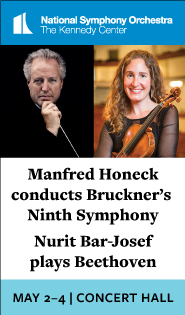NSO forces soar in Auerbach’s awesome Arctic premiere

Led by Teddy Abrams, the National Symphony Orchestra performed the world premiere of Lera Auerbach’s “ARCTICA” Saturday night with the composer at the keyboard. Photo: Tracey Salazar
The National Symphony Orchestra’s concerts this past week, led by Teddy Abrams, featured music composed in homage to the natural world, as well as music lamenting the damage done to it by human development and industry.
The main event took place Saturday night when the NSO gave the world premiere of ARCTICA, a large new choral and symphonic work by Lera Auerbach, in the Kennedy Center Concert Hall.
Auerbach visited the Arctic Circle and had many conversations with National Geographic explorer-in-residence Enric Sala, as part of this co-commission by the National Geographic Society and the NSO. Auerbach even learned enough of the Inuit languages to be able to write her own libretto in the Alaskan vernacular.
After a single hearing, it was clear that the piece makes a grand statement. Like most music by Auerbach, it sounds unlike that of almost any other composer, with the possible exception of Prokofiev. Auerbach herself played the solo piano part, although the work is not a piano concerto in any traditional sense. She has likened the piano to an Inuit spirit guide, presiding over a vision that leads backward from the arrival of Europeans in the Arctic to the beginning of time.
Auerbach and Abrams entered unobtrusively without applause, so that the darkening of the auditorium lights could signal the start of the piece. Recorded drips of water punctuated the dark silence. A large battery of exotic percussion instruments mimicked other watery sounds, while the sound of cracking ice was produced literally. An amplified percussionist, wearing protective goggles and surrounded by a glass shell, struck ice with mallets, producing a fury of splintered chips at one climax.
Members of the Washington Chorus, arrayed in the chorus seats above the stage, moaned, growled, cackled, and howled through the series of shaman-led visions. A section dotted with bird calls from the percussion and woodwinds elicited crazy shouts, groaning vocal glissandi often answered by unexpected keening sounds from flexatone and theremin. Four soloists from the chorus, standing in the front row, added individual lines, most prominently soprano Deborah Sternberg and mezzo-soprano Natalia Kojanova.
The work came to a cataclysmic climax in a solemn march, powered by a bass ostinato. It grew and grew in deafening sound, finally cutting off just before it reached a satisfying resolution, leaving the opening sound world in dazzled quiet, the vision ripped away. Much like a vision, one imagines, the piece is an intriguingly chaotic jumble. While the rambling words and sections of the libretto were impossible to follow in the hurly-burly of the moment, it was fully satisfying just to let the music wash over and float along with it.
Abrams, the music director of the Louisville Orchestra, held the piece together with tense, energetic gestures. His beat was outsized and not always clear, which led to some disappointing, four-square renditions of the music on the first half.
Both Dvořák’s overture In Nature’s Realm and Sibelius’s tone poem The Oceanides felt more agitated than pastoral or grand. The Sibelius, in particular, which should be a tapestry of diaphanous effects, felt rushed, too much focused on the tidal crescendo powered by the brass near the end.
Before intermission the NSO also gave its first performance of Sea-Blue Circuitry by Mason Bates. Although Bates eschewed his usual electronic beat track, he wrote percussion and woodwind parts that sounded much the same. Bustling outer movements, consisting largely of syncopated patterns, tripped along to the clacking of a typewriter included in the battery. The slow middle movement seemed suspended underwater, distant bells tolling over long chords.
The first performance of this program on Thursday differed only in the last piece on the program. Instead of the Auerbach premiere, the Choral Arts Society of Washington took part in the NSO’s first performance of Itaipú, Philip Glass’s 1989 symphonic cantata, evoking the massive hydroelectric dam on the Paraná River between Paraguay and Brazil.
Individual voices came out of the choral texture jarringly in the quieter opening section, but as the powerful sweep of water took the listener out to sea, the chorus and orchestra engulfed the hall in drenching sound. The damming of the river—which sank an enormous natural waterfall beneath a manmade lake—seemed both awe-inspiring and terrifying in its musical depiction.



